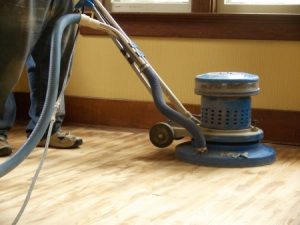
Hardwood flooring is an incredibly durable and resilient flooring option, made all the more popular by the attractive look that it can add to a home. Refinishing hardwood floors is a fairly straightforward task, whether you’re looking to rejuvenate flooring that had been concealed by carpet or just refresh your floor’s shine that has dulled with heavy wear. In this entry, we’ll walk you through the process of refinishing your hardwood floors.
Updating Your Hardwood Flooring
To start, you will need some chamois cloths or towels, dry tacking cloths, some high-grit sandpaper, a buffer with a sanding pad or a floor sander, a long-handled roller and some fresh finish. You should begin by clearing all the furniture from the room that you intend to refinish, including throw rugs or any other items on the floor. Once you’ve cleared everything out, it’s time to clean. Wash down the floor with a specialized hardwood floor cleaning solution or vinegar-water mix, using a chamois cloth or a towel to wipe the solution. You should also prepare to contain sanding debris in the room by closing windows and doors in the room or hanging drop cloths to help prevent dust from carrying throughout your home.
Hand Sanding the Hard-to-Reach Places
After cleaning, start hand sanding the floor in the room’s corners, narrow areas and the perimeter of the floor along the walls that cannot be reached easily with a buffer sander. This should be done from 4 to 6 inches along the edges using the high-grit sandpaper. You should also do this by hand as a block may miss uneven spots that you may be able to feel when sanding by hand.
Using a Buffer Sander
Once you’ve sanded a few inches from the wall throughout the room, you can advance to sanding the main portion of the room with a buffer sander. Sanding with the buffer should be done with a side-to-side sweeping motion in the direction of the floor’s grain, maintaining continuous, fluid motion and slightly overlapping your movements to prevent uneven sanding. You should wear a dust mask while sanding in this fashion, and stop every few minutes to check and clean off the sanding pad to remove any stuck-on dust.
Let the room sit undisturbed for 15 minutes to half an hour after you’ve finished sanding to let dust settle and collect. Next, sweep and vacuum the flooring, using the broom to loosen any debris that has settled between floorboards. You should also use a dry tack cloth to help pull out any remaining dust that may still be present.
Refinishing Your Hardwood Flooring
Now you can start refinishing the floor. Start by straining finish into a small pan. Brush a small amount of the finish along the areas you hand sanded previously, remembering to work quickly to prevent this first application from drying prematurely. Then pour a narrow band of the finish along the grain of the floor and roll the new finish over the floor with a long-handled roller. Work in adjoining sections of the room, keeping in mind the small 10- to 15-minute window between application and drying. Once complete, let the finish dry for three to four hours before applying another coat in the same fashion.
A freshly finished floor should remain undisturbed for about a week before you bring furniture back in, as this gives the wood time to fully dry and absorb the finish. Once complete, though, you’ll have a beautiful new look and a fresh, protected floor that will last for many years to come.
Have the know-how but not the tools? Give us a call today for more information on all the products available at Lawrence Tool Rental.

Leave a Reply